Data Formats for Data Science
The plain text is one of the simplest yet most intuitive format in which data could be stored. It is easy to create, human and machine readable, storage-friendly (i.e. highly compressible), and quite fast to process. Textual data can also be easily structured; in fact to date the CSV (Comma Separated Values) is the most common data format among data scientists.
However, this format is not properly suited in case data require any sort of internal hierarchical structure, or if data are too big to fit in a single disk.
In these cases other formats must be considered, according to the shape of data, and the specific constraints imposed by the context. These formats may leverage general purpose solutions, e.g. [No]SQL databases, HDFS (Hadoop File System); or may be specifically designed for scientific data, e.g. hdf5, ROOT, NetCDF.
In this talk, the strength and flaws of each solution will be discussed, focusing on their usage for scientific computations. The goal is to provide some practical guidelines for data scientists, derived from the the comparison of the different Pythonic solutions presented for the case study analysed. These will include
xarray,
pyROOT vs rootpy, h5py vs PyTables, bcolz, and blaze.
Finally, few notes about the new trends for columnar databases (e.g. MonetDB) will be also presented, for very fast
in-memory analytics.

Thank you. Marco.